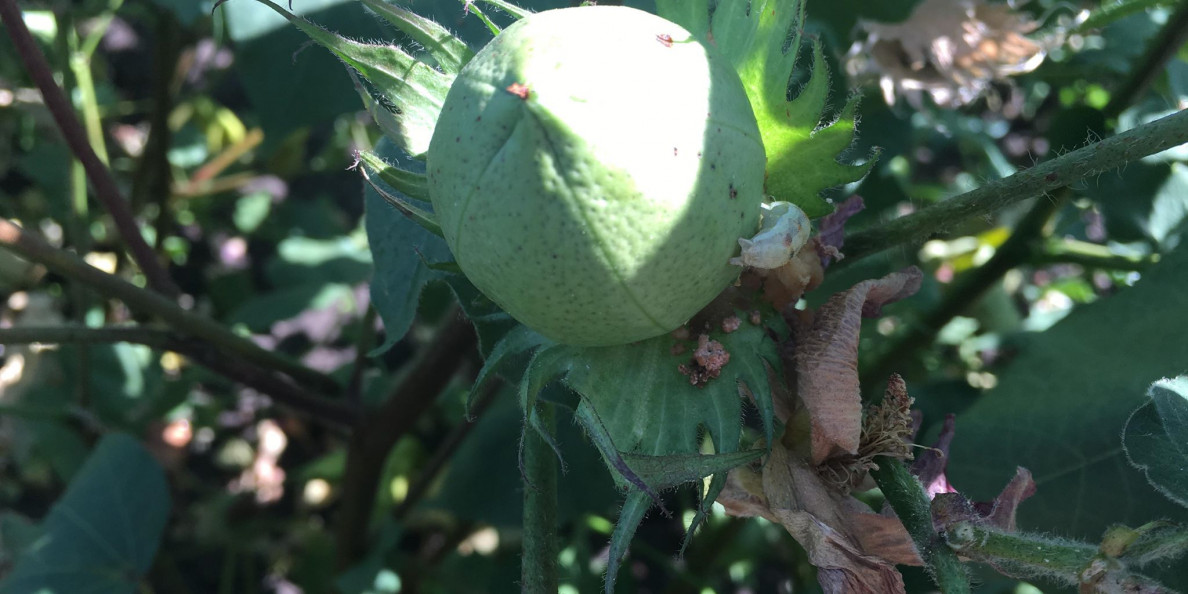Scientists have used genomics and gene editing to discover a genetic mutation that makes cotton bollworm caterpillars—one of the world’s most destructive cotton pests—resistant to genetically engineered cotton.
The method may signal a new era in efforts to promote more sustainable pest control.
Cotton, corn, and soybeans have been genetically engineered to produce pest-killing proteins from the widespread soil bacterium Bacillus thuringiensis, or Bt. Non-toxic to people and wildlife including bees, these environmentally friendly Bt proteins are in sprays by organic growers for more than 50 years and in engineered Bt crops millions of farmers have planted worldwide on a cumulative total of more than two billion acres since 1996.
As reported in the Proceedings of the National Academy of Sciences, entomologists wanted to pinpoint the mutation conferring Bt resistance in bollworms, precisely edit one bollworm gene to prove this mutation causes resistance, and discover how the resistance is spreading through cotton fields in China.
“It’s a remarkable detective story,” says coauthor Bruce Tabashnik, professor in the entomology department at the University of Arizona and a member of the BIO5 Institute. “Without the latest advances in genetic technology, it would not have been possible to find the single DNA base pair change causing resistance among the hundreds of millions of base pairs in the bollworm’s genome.”
17,000 GENES TO JUST 21
For years, scientists have known that insects can evolve resistance to Bt proteins, just as they have to conventional insecticides. However, insects have passed Bt resistance down recessively in nearly all previously studied cases. This means insects must have two copies of the resistance gene—one from each parent—to enable them to feed and survive on the Bt crop.
To combat resistance, farmers plant refuges of non-Bt crops, where susceptible insects can thrive. The idea is the rare resistant insects will mate with the more abundant susceptible insects from refuges, producing offspring that harbor only one copy of the resistance gene. With recessively inherited resistance, such offspring don’t survive on the Bt crop.
Though refuges do not stop evolution of resistance altogether, they can delay it substantially—particularly when resistance is recessive.
But in China, the paper reports, dominant bollworm resistance to Bt is on the rise. Only one copy of a dominant mutation makes a bollworm resistant.
Because the genetic basis of dominant Bt resistance was previously unknown, the researchers had to scrutinize the bollworm’s entire genome to find the culprit. By comparing the DNA of resistant and susceptible bollworms, they narrowed the search from 17,000 genes to a region of just 21 genes associated with resistance.
“But only 17 of those genes code for proteins that are produced by the caterpillars,” Tabashnik says, explaining that only the bollworm caterpillars feed on cotton and can be killed by Bt proteins.
“In comparing the sequences of those 17 genes between the strains, there was only one consistent difference,” Tabashnik says. “There was one position where all of the resistant bollworms had one DNA base pair and all of the susceptible bollworms had a different DNA base pair.”
CRISPR EDITING
This pivotal base pair is in a newly identified gene named HaTSPAN1, which codes for a tetraspanin—a protein containing four segments that span cell membranes. Although the normal function of HaTSPAN1 is not known, many other tetraspanins are important in cell-to-cell communication. Despite nearly 30,000 previous studies of either Bt or tetraspanins, the new study is the first to find a strong connection between them.
With the mutant base pair identified, the second challenge was to determine if this single mutation causes resistance. To find out, the research team used the gene-editing tool CRISPR to precisely alter only the HaTSPAN1 gene. When researchers disrupted the gene in resistant bollworms, they became completely susceptible to Bt. Conversely, when researchers inserted the mutation into the DNA of susceptible bollworms, they became resistant—proving this single base pair change alone can cause resistance.
The final step was testing the hypothesis that this mutation contributes to resistance to Bt cotton in the field. By screening for the mutation in the DNA of thousands of preserved bollworm moths researchers collected between 2006 and 2016, they found the frequency of the mutation increased by a factor of 100, from 1 in 1,000 to 1 in 10.
The resistant bollworms are not yet numerous enough to noticeably decrease cotton production in China, but the dominant gene is spreading faster than other resistance genes. Tabashnik’s analysis predicts that if the current trend continues, this mutation will confer resistance to half of northern China’s cotton bollworms within five years.
“If things continue on the same trajectory, this is the mutation that is going to cause problems for the farmers in the field,” Tabashnik says.
It is early enough, however, for farmers in China to change their tactics and ward off Bt resistance. They could switch from cotton that produces only one Bt protein to the types of cotton grown in the United States and Australia, which produce two or three distinct Bt proteins. Tabashnik hopes the new research will spur enhanced sustainability for farmers.
“It gives them the information to make constructive, proactive decisions before it’s too late,” Tabashnik says.
By sampling pest populations from year to year, farmers and researchers may be able to learn which methods are most effective for thwarting resistance.
Understanding bollworm resistance has global implications because it occurs in over 150 countries and now threatens to invade the United States.
“It will be interesting to screen for this mutation in cotton bollworm from Australia, India, and Brazil,” says Yidong Wu, a professor of entomology at Nanjing Agricultural University who led the research in China.
Grants from the National Natural Science Foundation of China and the Ministry of Agriculture and Rural Affairs of China, as well as USDA National Institute of Food and Agriculture grants from the Biotechnology Risk Assessment Research Grant program and from the Agriculture and Food Research Initiative Program funded the work.
Source: University of Arizona


